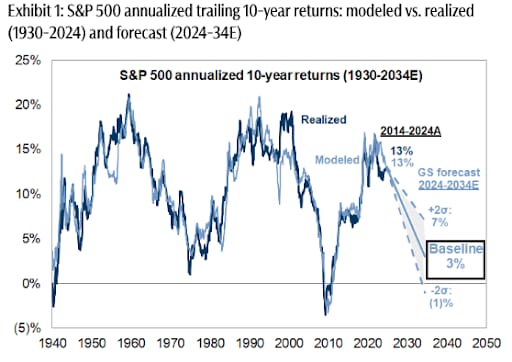- NextGen News
- Posts
- 🌎 Trump vs. China
🌎 Trump vs. China
President Trump faces a renewed trade war with China, a rare desert bloom occurs in the driest desert on Earth, JPMorgan requires face scans for its employees, and much more.

Are the US and China back in another trade war?

McGill / NextGen News
They’re really just like two bickering siblings. After months of de-escalating trade tensions, the US and China are back at it again following a series of spats that have both countries taking the gloves off.
What’s going on?
Last week, China unleashed unprecedentedly strict export controls on rare earth minerals and announced that it will now force foreign companies to get approval before exporting products made with them.
In response, President Trump threatened to impose 100% tariffs on Chinese goods (which is already at 40%) and restrictions on “any and all critical software” to China, which could slow its AI, semiconductor, and industrial ambitions.
President Trump went on to say that China is exploiting its “monopoly” over rare earths to try and get a leg up in trade negotiations.
Why are rare earths so important to the US? The group of 17 metals (see list) are crucial for developing advanced tech like semiconductors, smartphones, EVs, a slew of defense technology, and more. Currently, China dominates the market, controlling over 50% of mining and over 90% of processing.
Will this blow up into another trade war?
While things certainly looked bleak over the weekend (especially after US stocks took a nosedive after the trade dispute), the situation is looking up after Treasury Secretary Scott Bessent confirmed the US and China are looking to de-escalate:
Yesterday, Bessent confirmed that the two nations have resumed talks, and more detailed discussions are expected during next week’s IMF and World Bank meetings in Washington.
Bessent also pushed back on Trump’s threat of 100% tariffs on Chinese goods, saying drastic measures “do not have to happen” if China reverses its export controls.
Looking forward: Despite the diplomatic outreach, Trump still seems to be committed to the tariff threat and has warned that a planned meeting with President Xi in South Korea could be canceled if China doesn’t back off.

Europe debuts its new border checkpoint system

Karl-Josef Hildenbrand / Getty Images
Prepare for a fingerprint scan before your vacation to Paris. The European Union began rolling out its revamped border screening process yesterday, called the Entry-Exit System (EES), which replaces manually stamped passports with biometric data.
How does it work?
Non-EU citizens will be required to have their photograph taken and their fingerprints scanned before entering the Schengen area, which includes most of Europe, along with Iceland, Norway, Switzerland, and Liechtenstein.
Under the new protocol:
Travelers will register their biometric information at airport kiosks (except children under 12, who are exempt from fingerprinting), and those who refuse will be denied entry.
Data will be stored for three years and, under certain conditions, shared with other countries or global agencies.
As of writing, 29 countries have already adopted EES, with Estonia, Luxembourg, and the Czech Republic applying the process to all travellers, while some others are slowly rolling it out in phases. All but two of the EU member states will participate in the update.
It’s about to get busy
Before the new screening process even began, officials were lambasted with concerns that the system would exacerbate wait times, as travellers from across the world have yet another hoop to jump through.
So far, it’s looking like the critics were right:
The Port of Dover anticipates that car processing will spike from under a minute to six minutes per vehicle, even though it invested in infrastructure upgrades.
France, the world’s top tourist destination, hired hundreds of new employees to try and curb increased traffic.
Julia Lo Bue-Said, the chief executive of a leading travel agency, warned those crossing the border (especially at airports) to leave “an extra four hours” early, as many are seeing bottlenecks already.
So, what areas will be the busiest? Major airports, like Amsterdam and Frankfurt, are likely to see the biggest delays. Officials say to avoid border crossings with high volumes and limited space, where queues may spill into adjacent roads or overflow areas, further increasing already long wait times.

The world’s driest desert is experiencing a rare flower bloom

Lucas Aguayo Araos / Getty Images
I guess the Atacama Desert decided to try color this season. Chile’s Atacama Desert, known as one of the driest places on Earth, is currently undergoing a rare transformation that happens once every seven years.
Nowhere on Earth does this phenomenon occur like it does here in Chile,
Flower power
Sitting around 8,000–13,000 feet above sea level, the Atacama is the driest place on Earth outside the poles, averaging under 0.1 inches of rain per year. One town, Calama, reportedly saw no rainfall for nearly 400 years.
This winter, though, parts of the “flowering desert” received an unprecedented 2.3 inches, triggering one of the Earth’s most delicate phenomena:
Over 200 seed species, long dormant in the dry soil and waiting for the perfect conditions, finally bloomed.
The result is one of Acatama’s most colorful years on record, with vibrant hues of pink, purple, yellow, red, white, and blue carpeting the desert. See photos of the bloom here.
Why is it so rare? Besides some extremely rare rainfall, the seeds need just the right amount of balance of temperature, daylight, and humidity in order to activate, and even then, there is no guarantee that they will bloom.
Unfortunately, it won’t be here for long: Most blossoms are expected to vanish by November, though a few drought-resistant species might survive into January with a little luck.
In partnership with Masterworks
Wall Street Isn’t Warning You, But This Chart Might
Vanguard just projected public markets may return only 5% annually over the next decade. In a 2024 report, Goldman Sachs forecasted the S&P 500 may return just 3% annually for the same time frame—stats that put current valuations in the 7th percentile of history.
Translation? The gains we’ve seen over the past few years might not continue for quite a while.
Meanwhile, another asset class—almost entirely uncorrelated to the S&P 500 historically—has overall outpaced it for decades (1995-2024), according to Masterworks data.
Masterworks lets everyday investors invest in shares of multimillion-dollar artworks by legends like Banksy, Basquiat, and Picasso.
And they’re not just buying. They’re exiting—with net annualized returns like 17.6%, 17.8%, and 21.5% among their 23 sales.*
Wall Street won’t talk about this. But the wealthy already are. Shares in new offerings can sell quickly but…
*Past performance is not indicative of future returns. Important Reg A disclosures: masterworks.com/cd.

Ferrari’s stock hits the brakes in record drop

andreafidone / Getty Images
Red is now the signature color of Ferrari’s share price, too. The Italian sports car maker saw its worst trading day in history last week after the company released a cautious long-term forecast, only for its stock to, well, keep dropping this week.
Seeing red
Shares in Ferrari $RACE ( ▼ 3.01% ) fell 15% on Wednesday, marking the company’s largest single-day decline in over a decade. The luxury car company’s stock is now down over 20% as of writing.
So what went wrong? The main disappointment was that Ferrari lowered its 2030 revenue forecast to $10.4 billion, below Wall Street’s $11.3 billion target. But it was more than just that:
The company also indicated that adjusted earnings are expected to grow 6% annually through 2030, down from the 10% pace projected three years ago for 2022–2026, according to RBC Capital.
The regrettable announcement came as Ferrari was going all in on its first all-electric car, the Elettrica, which was created in partnership with Jony Ive (who helped design the iPhone).
While the luxury automaker unveiled parts of its 2026 model last week, it also scaled back its EV ambitions:
The company is now targeting a 20% fully electric lineup by 2030, down from 40%.
There is one silver lining: Ferrari remains Europe’s most valuable car maker by a mile, beating out Porsche, Lamborghini, and other rivals, so at least there’s that.

JPMorgan forces employees to do a face scan to access its new HQ

Michael Nagle / Bloomberg via Getty Images
We’re officially in the age of biometric data. JPMorgan Chase has informed employees at its new Manhattan headquarters that their biometric data, including fingerprints and eye scans, will be mandatory to get into work.
Access denied
Although the bank first said it would be voluntary, biometric access is now required to enter the brand new $3 billion skyscraper, according to the Financial Times.
That means staff will have to offer up a bit more than just their traditional ID badge:
In order to gain biometric access, employees will have to have their fingerprints or eyes scanned to enter through the building’s security gates.
Some employees will be allowed to just use their traditional ID badges, but the details on who that applies to remain unclear.
Why go all out on the dystopian vibe? The move is likely in response to security concerns following the fatal shooting of UnitedHealthcare’s CEO last year and a deadly shooting at the NFL headquarters in July, both of which were close to JPMorgan’s own HQ.
New home, new upgrades
The bank’s state-of-the-art facility is designed to house up to 14,000 employees when it opens later this year, and once they hand over their eyes, workers can hope to see a whole host of features across its 60 floors.
Its amenities include:
A 19-restaurant food court with food that can be delivered straight to employees’ desks.
Lighting is designed to support workers’ circadian rhythms and adjust temperature based on a worker’s preferences.
A health and wellness studio that offers physical therapy, yoga, and meditation classes.
And even a building-specific signature scent (similar to how luxury hotels do it).
JPMorgan isn’t stopping at just one tower: As the bank faces employee pushback over its five-day return-to-office policy, JPMorgan plans to upgrade additional nearby buildings, creating a multi-block campus to help its staff feel a little more compensated.
How did you like today's newsletter? |

Catch up on this week’s weird news

GIF via GIPHY
> Behavioral scientists have found that some dogs exhibit addiction-like behaviors toward toys, similar to how humans engage with gambling, gaming, and smartphones.
> Nike and Lego teamed up to create an interactive children’s playground in Shanghai, China, that focuses on creativity and imagination. To be honest, I thought it was an art exhibit at first.
> Scientists created an injectable gel that can restore voice loss and help heal vocal cord injuries. Unlike similar treatments, the gel lasted for weeks without breakdown, giving the vocal cords a higher chance to heal.
> Leila’s Hair Museum, a museum in Kansas City packed with collections of human hair displays, is officially shutting its doors. Some notable locks stored there include Marilyn Monroe, past presidents, and even Jesus.
> The latest novel transcribed to English by László Krasznahorkai, who was recently awarded the Nobel Prize in Literature, is a single sentence that unfolds over 400 pages. Talk about a run-on sentence.

Reply